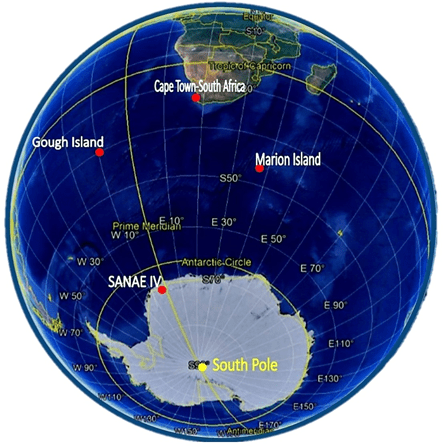
by Ria Olivier | May 6, 2024 | Important Dates, SA Agulhas II
 The Department of Forestry Fisheries and the Environment invites you to bring your entire family to come and experience a fun-filled day at the SA Agulhas II Open Day:
The Department of Forestry Fisheries and the Environment invites you to bring your entire family to come and experience a fun-filled day at the SA Agulhas II Open Day:
Date: 18 May 2024
Venue: Campanile Jetty, Port of Port Elizabeth/Gqeberha
Open 09h00 – Close 15h00
You and your family will have the unique opportunity of taking a tour of the S.A.Agulhas II research vessel. We also have our partners from the marine and maritime industry who will showcase their environmental work and scientific work.

by Ria Olivier | Apr 29, 2024 | Marion Island, Research, Take-Over Operations, Uncategorised
Marion Island Take-Over 2024 Ornithology Projects: Avian scavengers as indicators of recovery of an island biota and the FitzPatrick long-term monitoring of Albatross and Giant Petrels.
The activities during the take-over 2024 will be divided into (1) completing the activities of the 2021/23 SANAP project on avian scavengers, and (2) ensuring the smooth passing of the FitzPatrick Institute seabird long-term monitoring on to the South African Polar Research Infrastructure (SAPRI).
 ABOVE: Michelle Jones (M80), Vanessa Steven (M81), Prof Susie Cunningham (UCT FitzPatrick PI), Rhiannon Gill (M81), Prof Peter Ryan (UCT FitzPatrick), Chris Jones (M80)
ABOVE: Michelle Jones (M80), Vanessa Steven (M81), Prof Susie Cunningham (UCT FitzPatrick PI), Rhiannon Gill (M81), Prof Peter Ryan (UCT FitzPatrick), Chris Jones (M80)
Avian scavengers as indicators of recovery of an island biota : Since 2021, our SANAP project focussed on the three poorly known avian scavengers: Brown Skua, Kelp Gull, Black-faced Sheathbill, as well as some of the skua’s prey, the burrowing seabird species. Our project filled identified scientific gaps that were crucial for best planning of the mouse eradication and development of appropriate mitigation measures, and established baselines for the scavenger guild and their prey base against which the impact of a successful mouse eradication can be measured in years to come. The takeover 2024 will see the closure of this project that we are aiming to restart at the time of the mouse eradication.

 Above: Chris and Michelle Jones working with the Wandering Albatross during overwinter period
Above: Chris and Michelle Jones working with the Wandering Albatross during overwinter period
The FitzPatrick long-term monitoring of Albatross and Giant Petrels: The long-term demography monitoring of Wandering and Grey-headed Albatrosses and Northern Giant Petrels at Marion Island was started by the FitzPatrick Institute of African Ornithology (UCT) in the early 1980s. To ensure its continuity for years to come, it will become SAPRI’s responsibility from April/May 2024. In the forthcoming takeover, all information regarding the monitoring will be passed on to SAPRI to ensure the continuity in the data collected. Further, the annual whole island count of Grey-headed Albatross fledglings will be conducted and Wandering Albatrosses will be carefully checked to detect any potential mouse injuries that were first detected in breeding adults in April 2023.

 (left) Michelle Jones with Grey-headed Albatross and (right) Chris Jones with Common Diving Petrel
(left) Michelle Jones with Grey-headed Albatross and (right) Chris Jones with Common Diving Petrel
Principal Investigators
Take-Over Research team
Overwintering team 2023/24:
- Michelle Risi Jones (NMU/SAPRI)
- Christopher Jones (NMU)
- Text: Dr Maelle Connan
- Images : Chris and Michelle Jones

by Ria Olivier | Apr 24, 2024 | Biosecurity, Ecology, Marion Island, Mice Eradication, Take-Over Operations
The Marion Island mouSe Ecology (MISE) Project: Towards a comprehensive understanding of impacts of the invasive house mouse on the terrestrial biodiversity of Marion Island
 (Above: Azorella selago – left: intact, right: eaten by mice)
(Above: Azorella selago – left: intact, right: eaten by mice)
This SANAP-funded project will set out to model the terrestrial food web on Marion Island, with a specific focus of understanding the role of the the invasive house mouse (Mus musculus), on the biodiversity and ecosystem functioning of Marion Island. The house mouse is an apex terrestrial predator on the island, i.e. it has few to no natural predators, but probably has a major effect on organisms on the island from across the food chain. This exercise is of utmost importance because the house mouse has detrimental effects on a large percentage of species on the island, ranging from seabirds to plants and macroinvertebrates; yet, some of these impacts are not well understood. Also, mouse eradication is planned for Marion Island in 2025. Only if we know what the current impact of mice are on the Marion Island ecosystem, can we predict the efficacy of the eradication..

 (Above: Elmar van Rooyen and Rabia Mathakutha. Left: before departure. Right: On board S.A.Agulhas II with Marion Island in the back)
(Above: Elmar van Rooyen and Rabia Mathakutha. Left: before departure. Right: On board S.A.Agulhas II with Marion Island in the back)
A major aim in the coming year will be to assess plant seed herbivory by mice, to see how this may have affected vegetation dynamics, and how mouse removal may affect vegetation dynamics; and also to understand current levels of invertebrate biomass on Marion Island. Invertebrates make up a major portion of the mouse diet, and repeat sampling since the 1970s has shown successive decreases in biomass. We will also be collecting data for isotope analyses to understand the food web on Marion Island in order to predict knock-on effects of mouse eradication and predict ecosystem recovery. Finally, we will be continuing long-term monitoring programmes of plants and invertebrates that were recently started, and also conduct some repeat sampling of protocols that were conducted some decades ago in order to assess how the system has changed in the last decades.
- Principal Investigator: Michelle Greve
- Affiliation: Department of Plant and Soil Sciences, University of Pretoria
- Research Programme: Towards a comprehensive understanding of impacts of the invasive house mouse on the terrestrial biodiversity of Marion Island
- Participants:
Marion 81 Overwintering Team: Elmar van Rooyen (University of Pretoria – UP)
 Allow me to introduce myself briefly. I am a 29-year-old conservation ecologist with a profound passion for nature and exploration. I hold an M.Sc. degree in Conservation Ecology & Entomology and possess a diverse skill set that includes expertise in ecology, restoration ecology, horticulture, botany, entomology, education, and management. Throughout my career, my focus has predominantly been on Southern Afrotemperate forests, and I have accumulated significant experience in South African forest ecology. I am drawn to this expedition for several reasons. Foremost, the opportunity to explore the unique environment of Marion Island presents a once-in-a-lifetime chance for me to expand my knowledge and understanding of sub-Antarctic ecosystems. While I may not have prior experience with the island, I firmly believe that firsthand experience is the most effective way to comprehend its ecology and wildlife. Moreover, I am deeply committed to the conservation of natural habitats, and Marion Island’s status as a biodiversity hotspot underscores the urgency of our research efforts. The presence of invasive house mice poses a significant threat to the island’s flora and fauna, necessitating thorough investigation and potential eradication strategies. Additionally, I am eager to contribute to studies on the impact of alien plant species and assist in devising methods for their control. I have always had a profound appreciation for fieldwork, and I relish the opportunity to immerse myself in hands-on research once again. Marion Island’s rugged terrain and unique challenges excite me, and I am prepared to tackle them head-on in the pursuit of conservation objectives.
Allow me to introduce myself briefly. I am a 29-year-old conservation ecologist with a profound passion for nature and exploration. I hold an M.Sc. degree in Conservation Ecology & Entomology and possess a diverse skill set that includes expertise in ecology, restoration ecology, horticulture, botany, entomology, education, and management. Throughout my career, my focus has predominantly been on Southern Afrotemperate forests, and I have accumulated significant experience in South African forest ecology. I am drawn to this expedition for several reasons. Foremost, the opportunity to explore the unique environment of Marion Island presents a once-in-a-lifetime chance for me to expand my knowledge and understanding of sub-Antarctic ecosystems. While I may not have prior experience with the island, I firmly believe that firsthand experience is the most effective way to comprehend its ecology and wildlife. Moreover, I am deeply committed to the conservation of natural habitats, and Marion Island’s status as a biodiversity hotspot underscores the urgency of our research efforts. The presence of invasive house mice poses a significant threat to the island’s flora and fauna, necessitating thorough investigation and potential eradication strategies. Additionally, I am eager to contribute to studies on the impact of alien plant species and assist in devising methods for their control. I have always had a profound appreciation for fieldwork, and I relish the opportunity to immerse myself in hands-on research once again. Marion Island’s rugged terrain and unique challenges excite me, and I am prepared to tackle them head-on in the pursuit of conservation objectives.
Marion Takeover 2024: Rabia Mathakutha (South African Polar Research Infrastructure -SAPRI)
 Rabia is excited to participate in the 2024 Marion Island Relief Expedition. Rabia is an ecologist by training and will be working as part of the University of Pretoria research team towards a comprehensive understanding of impacts of the invasive house mouse on the terrestrial biodiversity of Marion Island. Rabia first visited the island as part of her Masters research project during the 2015 and 2016 relief expeditions. Rabia’s MSc in Plant Science was focused on understanding plant invasion potential and environmental change responses in the sub-Antarctic region, using Marion Island as a case study. This is when her passion for understanding and participating in the conservation of South Africa’s polar environment was ignited. In her current capacity, Rabia is a research coordinator for the Data, Products and Society (DPS) Integrated Facility of the South African Polar Research Infrastructure (SAPRI). She continues to support the polar research environment by ensuring coordinated access to research infrastructure and societal benefits through science engagement and science communication. Rabia views this chance to revisit the island as a once-in-a-lifetime opportunity, one that will not only build upon previous efforts in understanding plant dynamics but also advance our understanding of ecological processes in response to a threatening invader. There’s no better place to study this than Marion Island, our own natural laboratory, and where it’s most urgently needed. As part of the larger Mouse-Free Marion project, Rabia considers this as a significant contribution to global conservation efforts, and in her words, “saving the world!”.
Rabia is excited to participate in the 2024 Marion Island Relief Expedition. Rabia is an ecologist by training and will be working as part of the University of Pretoria research team towards a comprehensive understanding of impacts of the invasive house mouse on the terrestrial biodiversity of Marion Island. Rabia first visited the island as part of her Masters research project during the 2015 and 2016 relief expeditions. Rabia’s MSc in Plant Science was focused on understanding plant invasion potential and environmental change responses in the sub-Antarctic region, using Marion Island as a case study. This is when her passion for understanding and participating in the conservation of South Africa’s polar environment was ignited. In her current capacity, Rabia is a research coordinator for the Data, Products and Society (DPS) Integrated Facility of the South African Polar Research Infrastructure (SAPRI). She continues to support the polar research environment by ensuring coordinated access to research infrastructure and societal benefits through science engagement and science communication. Rabia views this chance to revisit the island as a once-in-a-lifetime opportunity, one that will not only build upon previous efforts in understanding plant dynamics but also advance our understanding of ecological processes in response to a threatening invader. There’s no better place to study this than Marion Island, our own natural laboratory, and where it’s most urgently needed. As part of the larger Mouse-Free Marion project, Rabia considers this as a significant contribution to global conservation efforts, and in her words, “saving the world!”.
Text and images by MISE.

by Ria Olivier | Apr 23, 2024 | Announcement, Gough Island, Overwintering Team
 (Back L – R) Meshack Mogorosi – Diesel Mechanic (DFFE) and Team Leader; Lucy Dorman – Field Assistant – Birder (RSPB); Mbulaheni Kelcey Maewashe – Senior Meteorological Technician (SAWS); Fulufhelo Brenda Khobo – Meteorological Technician (SAWS); Hannah Greetham – Field Assistant – Birder (RSPB); Fulufhelo Singo – Electrical Engineer (DFFE)
(Back L – R) Meshack Mogorosi – Diesel Mechanic (DFFE) and Team Leader; Lucy Dorman – Field Assistant – Birder (RSPB); Mbulaheni Kelcey Maewashe – Senior Meteorological Technician (SAWS); Fulufhelo Brenda Khobo – Meteorological Technician (SAWS); Hannah Greetham – Field Assistant – Birder (RSPB); Fulufhelo Singo – Electrical Engineer (DFFE)
(Front L – R) Mndeni Hlatshwayo – Medical Orderly (DFFE); Mayembe Kapenda – Communications Engineer (DFFE); James Burns – Meteorological Technician (SAWS)
- DFFE: Department of Forestry, Fisheries and the Environment
- SAWS: South African Weather Services
- RSPB: The Royal Society for the Protection of Birds
Photo available on SANAP website and on ALSA archive

by Ria Olivier | Apr 22, 2024 | Antarctica, International Days, Legacy
 EARTH DAY Theme 2024 – Planet v Plastics
EARTH DAY Theme 2024 – Planet v Plastics
Celebrating our remarkable planet on this extraordinary day. Earth Day is a reminder of the importance of environmental conservation and sustainability. Earth Day symbolises the need to protect our mother nature. It encourages every individual to think about environmental conservation and act accordingly. It speaks about the need to reduce carbon footprints, conserve natural resources, and protect wildlife and natural habitats.
The South African National Antarctic Programme (SANAP) objectives are to conserve develop and understand the environment and plays a crucial role in conserving the Antarctic Region. Studies done in the Antarctic are inextricably linked to our understanding of the entire Earth system and signals in Antarctica indicate past and future global changes. SANAP recognises the global and national importance of safeguarding the environment of the Antarctic and Southern Ocean and protecting the integrity of ecosystems, both marine and terrestrial, in the region. The programme takes cognisance of the presence of natural resources (both renewable and non-renewable) and the increased interest in their possible utilisation (both consumptive and non-consumptive).

SIGN THE GLOBAL PLASTIC TREATY
The Global Plastic Treaty is an opportunity for the United Nations and Governmental Organizations to prove the health of the planet and its citizens take priority over an industry threatening the health of every human on Earth. Most importantly, though, it is a chance for our world to come together as one, and truly pledge and commit themselves to restoring the planet, following the model of the successful international cooperation found in the Montreal Protocol. The Global Plastics Treaty has the potential to end plastic pollution, protect human health, and lead to a waste-free world. We cannot allow our governments to waste this pivotal opportunity.
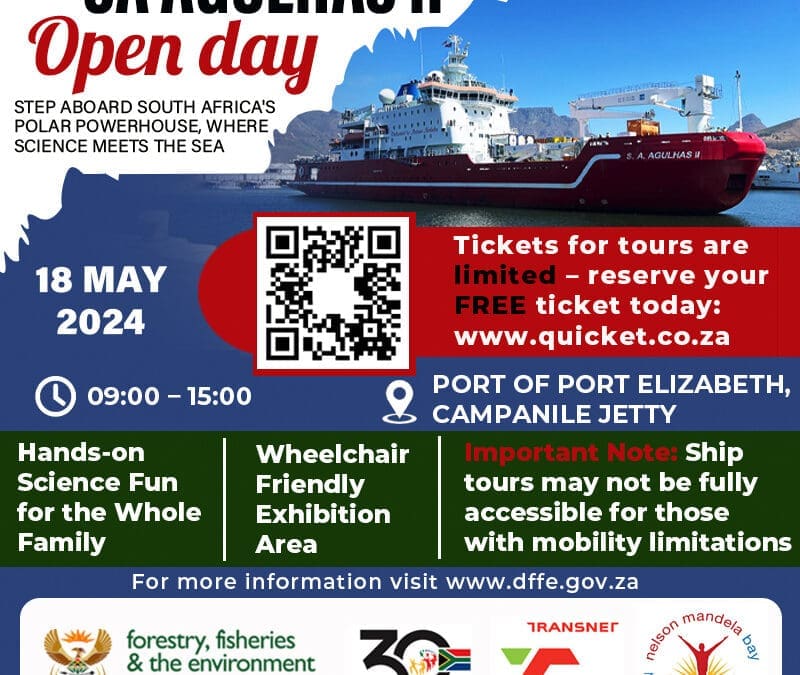
 The Department of Forestry Fisheries and the Environment invites you to bring your entire family to come and experience a fun-filled day at the SA Agulhas II Open Day:
The Department of Forestry Fisheries and the Environment invites you to bring your entire family to come and experience a fun-filled day at the SA Agulhas II Open Day:
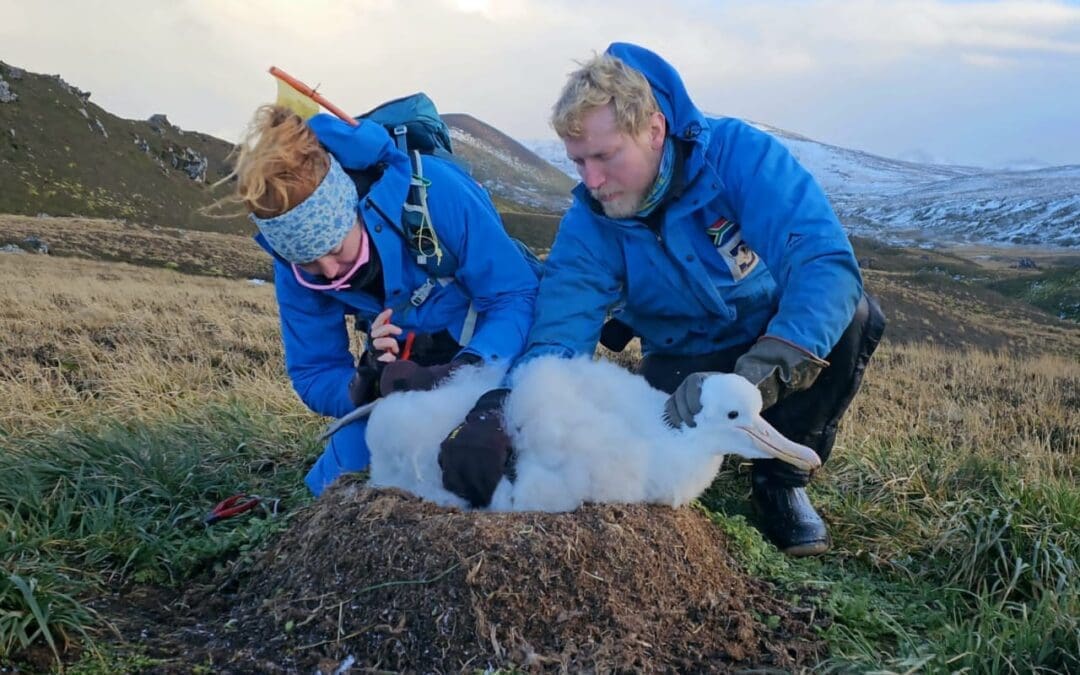
 ABOVE: Michelle Jones (M80), Vanessa Steven (M81), Prof Susie Cunningham (UCT FitzPatrick PI), Rhiannon Gill (M81), Prof Peter Ryan (UCT FitzPatrick), Chris Jones (M80)
ABOVE: Michelle Jones (M80), Vanessa Steven (M81), Prof Susie Cunningham (UCT FitzPatrick PI), Rhiannon Gill (M81), Prof Peter Ryan (UCT FitzPatrick), Chris Jones (M80)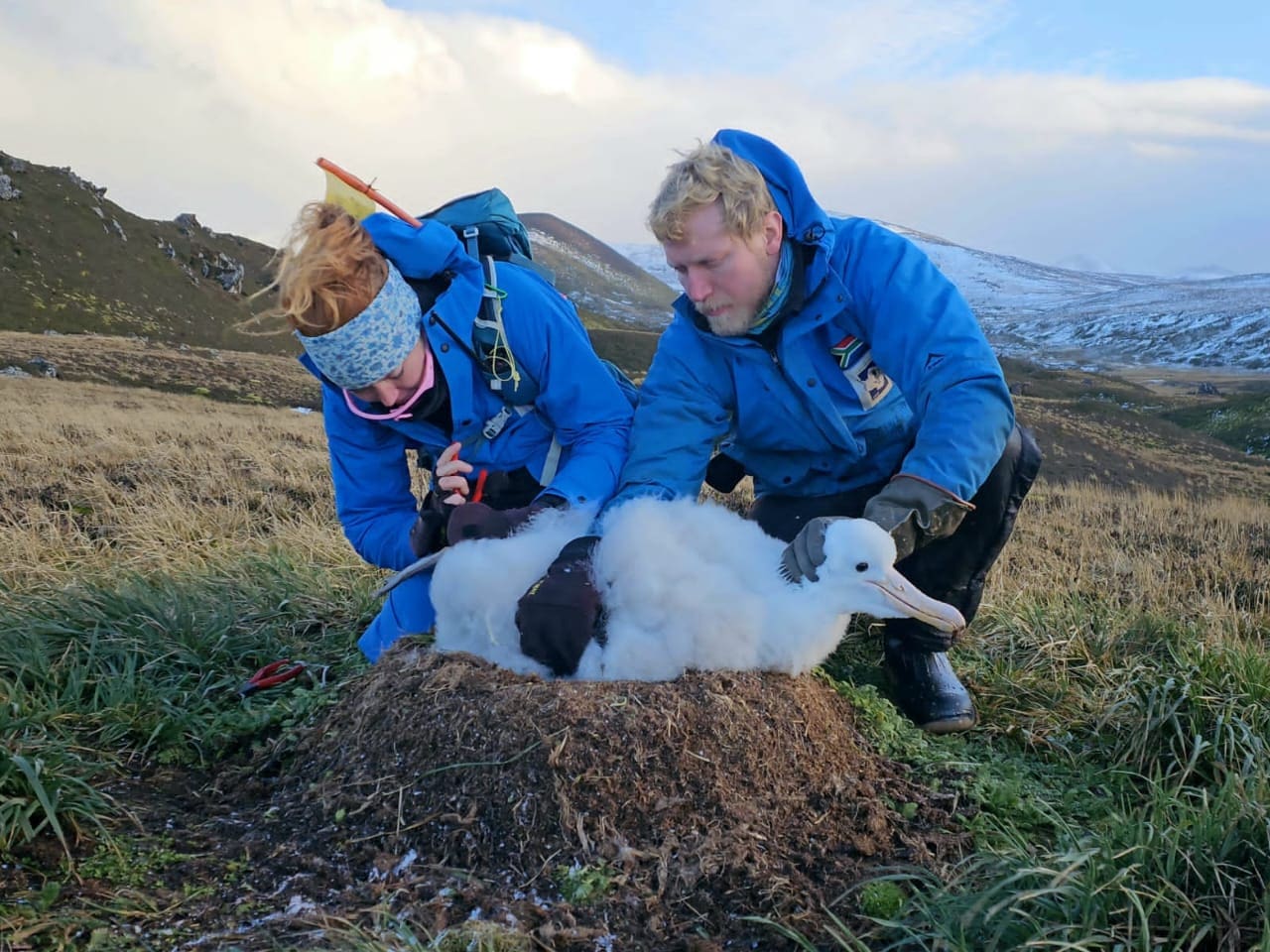
 Above: Chris and Michelle Jones working with the Wandering Albatross during overwinter period
Above: Chris and Michelle Jones working with the Wandering Albatross during overwinter period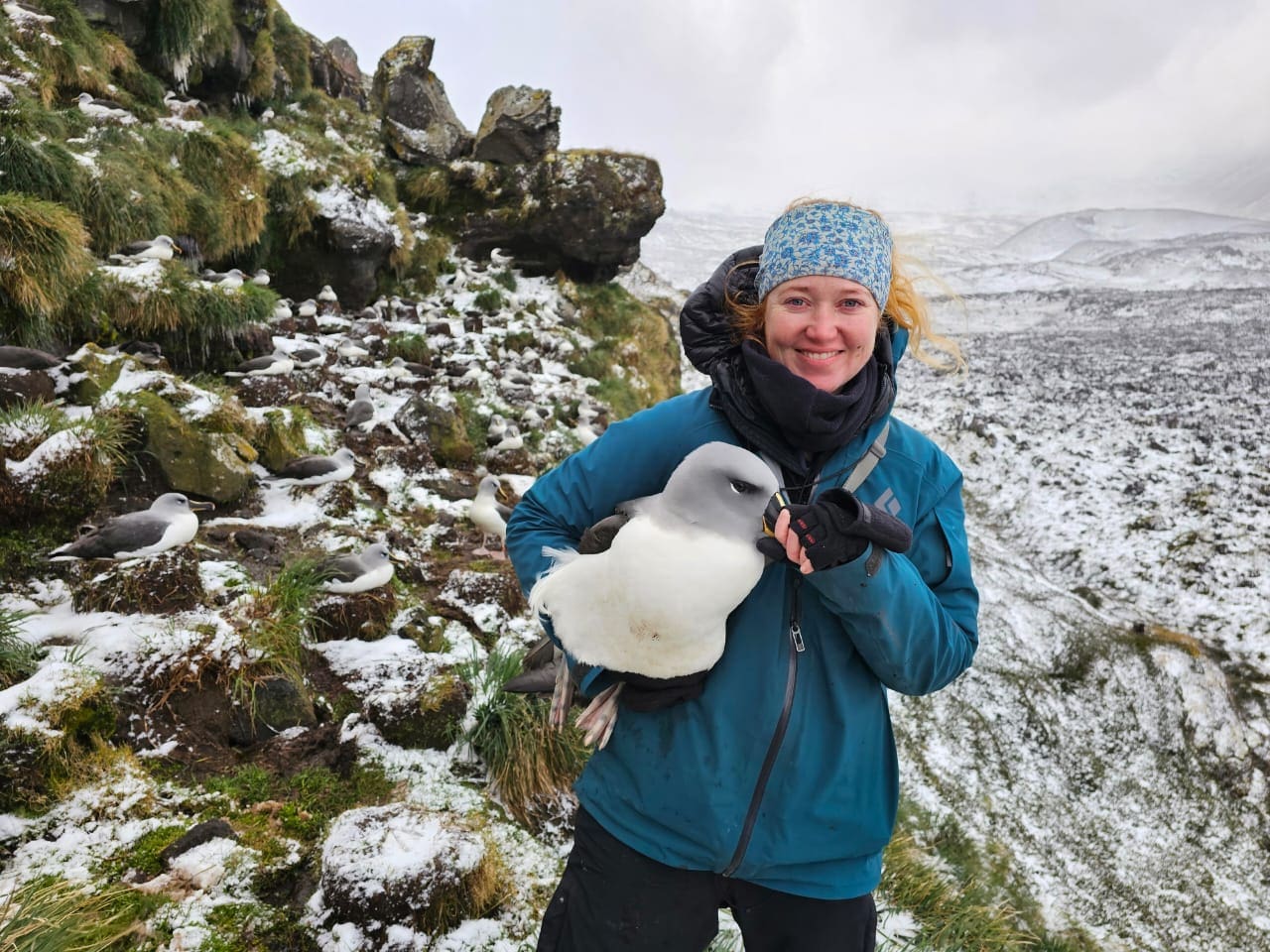
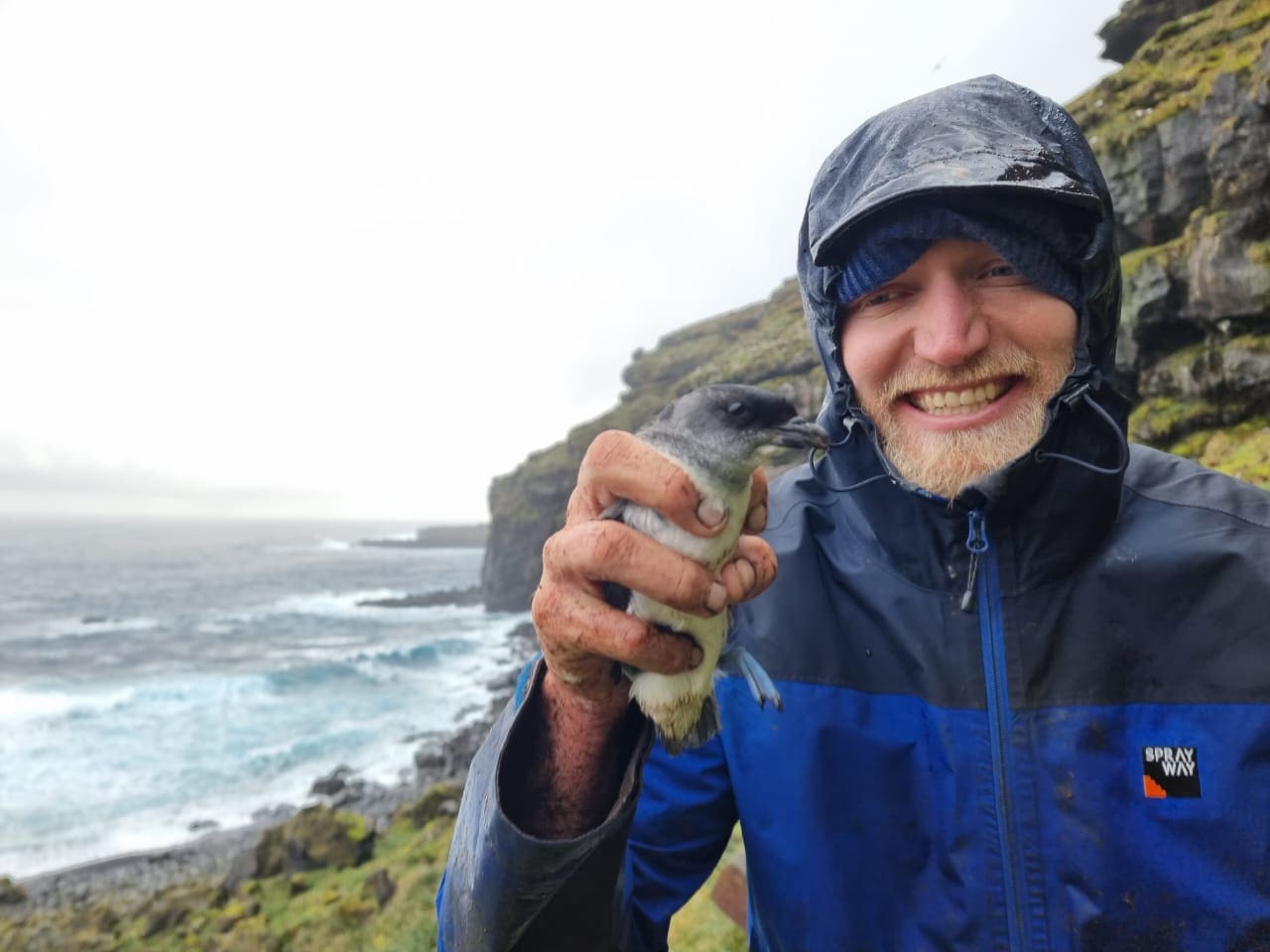 (left) Michelle Jones with Grey-headed Albatross and (right) Chris Jones with Common Diving Petrel
(left) Michelle Jones with Grey-headed Albatross and (right) Chris Jones with Common Diving Petrel
 (Above: Azorella selago – left: intact, right: eaten by mice)
(Above: Azorella selago – left: intact, right: eaten by mice)
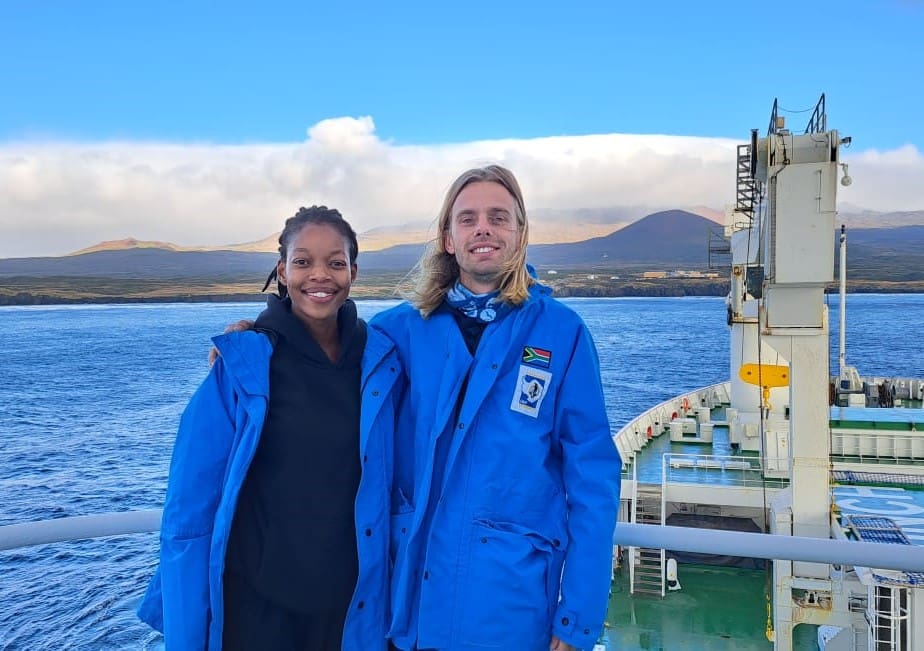 (Above: Elmar van Rooyen and Rabia Mathakutha. Left: before departure. Right: On board S.A.Agulhas II with Marion Island in the back)
(Above: Elmar van Rooyen and Rabia Mathakutha. Left: before departure. Right: On board S.A.Agulhas II with Marion Island in the back)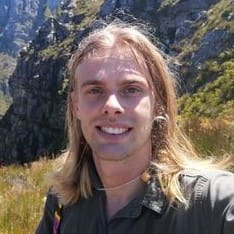 Allow me to introduce myself briefly. I am a 29-year-old conservation ecologist with a profound passion for nature and exploration. I hold an M.Sc. degree in Conservation Ecology & Entomology and possess a diverse skill set that includes expertise in ecology, restoration ecology, horticulture, botany, entomology, education, and management. Throughout my career, my focus has predominantly been on Southern Afrotemperate forests, and I have accumulated significant experience in South African forest ecology. I am drawn to this expedition for several reasons. Foremost, the opportunity to explore the unique environment of Marion Island presents a once-in-a-lifetime chance for me to expand my knowledge and understanding of sub-Antarctic ecosystems. While I may not have prior experience with the island, I firmly believe that firsthand experience is the most effective way to comprehend its ecology and wildlife. Moreover, I am deeply committed to the conservation of natural habitats, and Marion Island’s status as a biodiversity hotspot underscores the urgency of our research efforts. The presence of invasive house mice poses a significant threat to the island’s flora and fauna, necessitating thorough investigation and potential eradication strategies. Additionally, I am eager to contribute to studies on the impact of alien plant species and assist in devising methods for their control. I have always had a profound appreciation for fieldwork, and I relish the opportunity to immerse myself in hands-on research once again. Marion Island’s rugged terrain and unique challenges excite me, and I am prepared to tackle them head-on in the pursuit of conservation objectives.
Allow me to introduce myself briefly. I am a 29-year-old conservation ecologist with a profound passion for nature and exploration. I hold an M.Sc. degree in Conservation Ecology & Entomology and possess a diverse skill set that includes expertise in ecology, restoration ecology, horticulture, botany, entomology, education, and management. Throughout my career, my focus has predominantly been on Southern Afrotemperate forests, and I have accumulated significant experience in South African forest ecology. I am drawn to this expedition for several reasons. Foremost, the opportunity to explore the unique environment of Marion Island presents a once-in-a-lifetime chance for me to expand my knowledge and understanding of sub-Antarctic ecosystems. While I may not have prior experience with the island, I firmly believe that firsthand experience is the most effective way to comprehend its ecology and wildlife. Moreover, I am deeply committed to the conservation of natural habitats, and Marion Island’s status as a biodiversity hotspot underscores the urgency of our research efforts. The presence of invasive house mice poses a significant threat to the island’s flora and fauna, necessitating thorough investigation and potential eradication strategies. Additionally, I am eager to contribute to studies on the impact of alien plant species and assist in devising methods for their control. I have always had a profound appreciation for fieldwork, and I relish the opportunity to immerse myself in hands-on research once again. Marion Island’s rugged terrain and unique challenges excite me, and I am prepared to tackle them head-on in the pursuit of conservation objectives.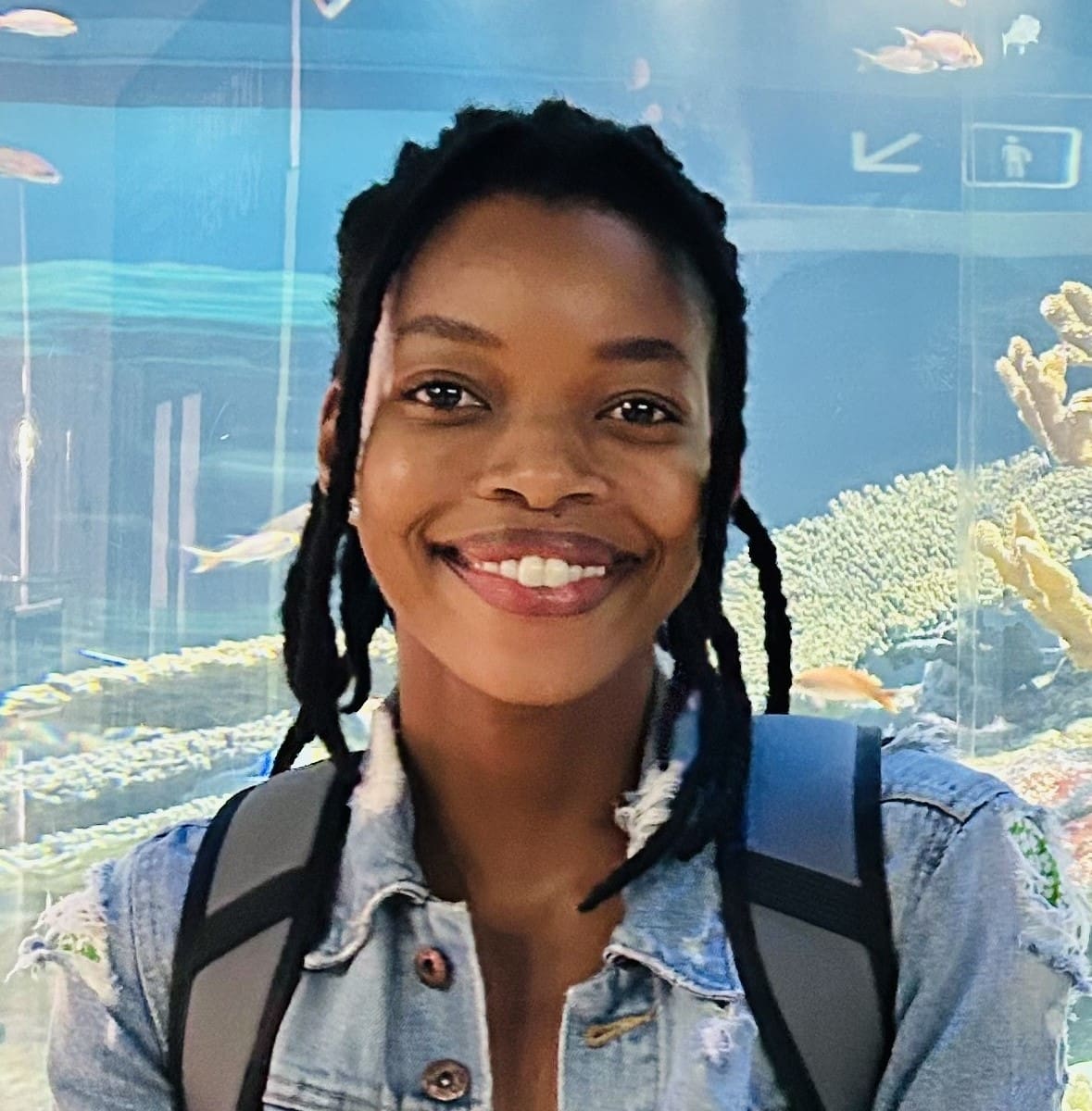 Rabia is excited to participate in the 2024 Marion Island Relief Expedition. Rabia is an ecologist by training and will be working as part of the University of Pretoria research team towards a comprehensive understanding of impacts of the invasive house mouse on the terrestrial biodiversity of Marion Island. Rabia first visited the island as part of her Masters research project during the 2015 and 2016 relief expeditions. Rabia’s MSc in Plant Science was focused on understanding plant invasion potential and environmental change responses in the sub-Antarctic region, using Marion Island as a case study. This is when her passion for understanding and participating in the conservation of South Africa’s polar environment was ignited. In her current capacity, Rabia is a research coordinator for the Data, Products and Society (DPS) Integrated Facility of the South African Polar Research Infrastructure (SAPRI). She continues to support the polar research environment by ensuring coordinated access to research infrastructure and societal benefits through science engagement and science communication. Rabia views this chance to revisit the island as a once-in-a-lifetime opportunity, one that will not only build upon previous efforts in understanding plant dynamics but also advance our understanding of ecological processes in response to a threatening invader. There’s no better place to study this than Marion Island, our own natural laboratory, and where it’s most urgently needed. As part of the larger Mouse-Free Marion project, Rabia considers this as a significant contribution to global conservation efforts, and in her words, “saving the world!”.
Rabia is excited to participate in the 2024 Marion Island Relief Expedition. Rabia is an ecologist by training and will be working as part of the University of Pretoria research team towards a comprehensive understanding of impacts of the invasive house mouse on the terrestrial biodiversity of Marion Island. Rabia first visited the island as part of her Masters research project during the 2015 and 2016 relief expeditions. Rabia’s MSc in Plant Science was focused on understanding plant invasion potential and environmental change responses in the sub-Antarctic region, using Marion Island as a case study. This is when her passion for understanding and participating in the conservation of South Africa’s polar environment was ignited. In her current capacity, Rabia is a research coordinator for the Data, Products and Society (DPS) Integrated Facility of the South African Polar Research Infrastructure (SAPRI). She continues to support the polar research environment by ensuring coordinated access to research infrastructure and societal benefits through science engagement and science communication. Rabia views this chance to revisit the island as a once-in-a-lifetime opportunity, one that will not only build upon previous efforts in understanding plant dynamics but also advance our understanding of ecological processes in response to a threatening invader. There’s no better place to study this than Marion Island, our own natural laboratory, and where it’s most urgently needed. As part of the larger Mouse-Free Marion project, Rabia considers this as a significant contribution to global conservation efforts, and in her words, “saving the world!”.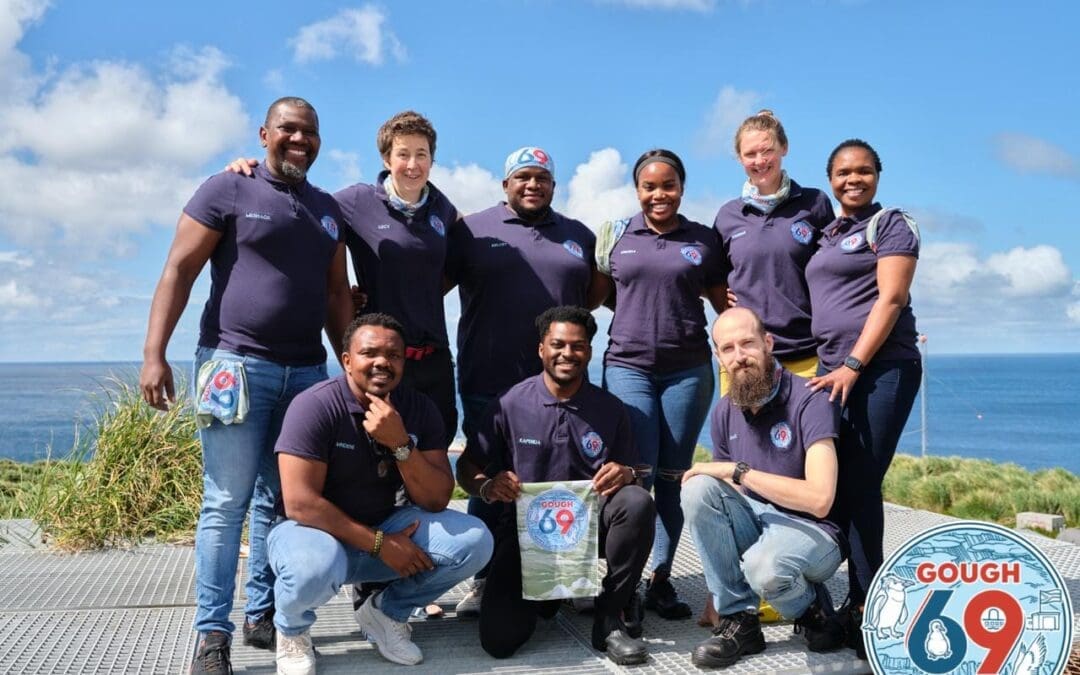
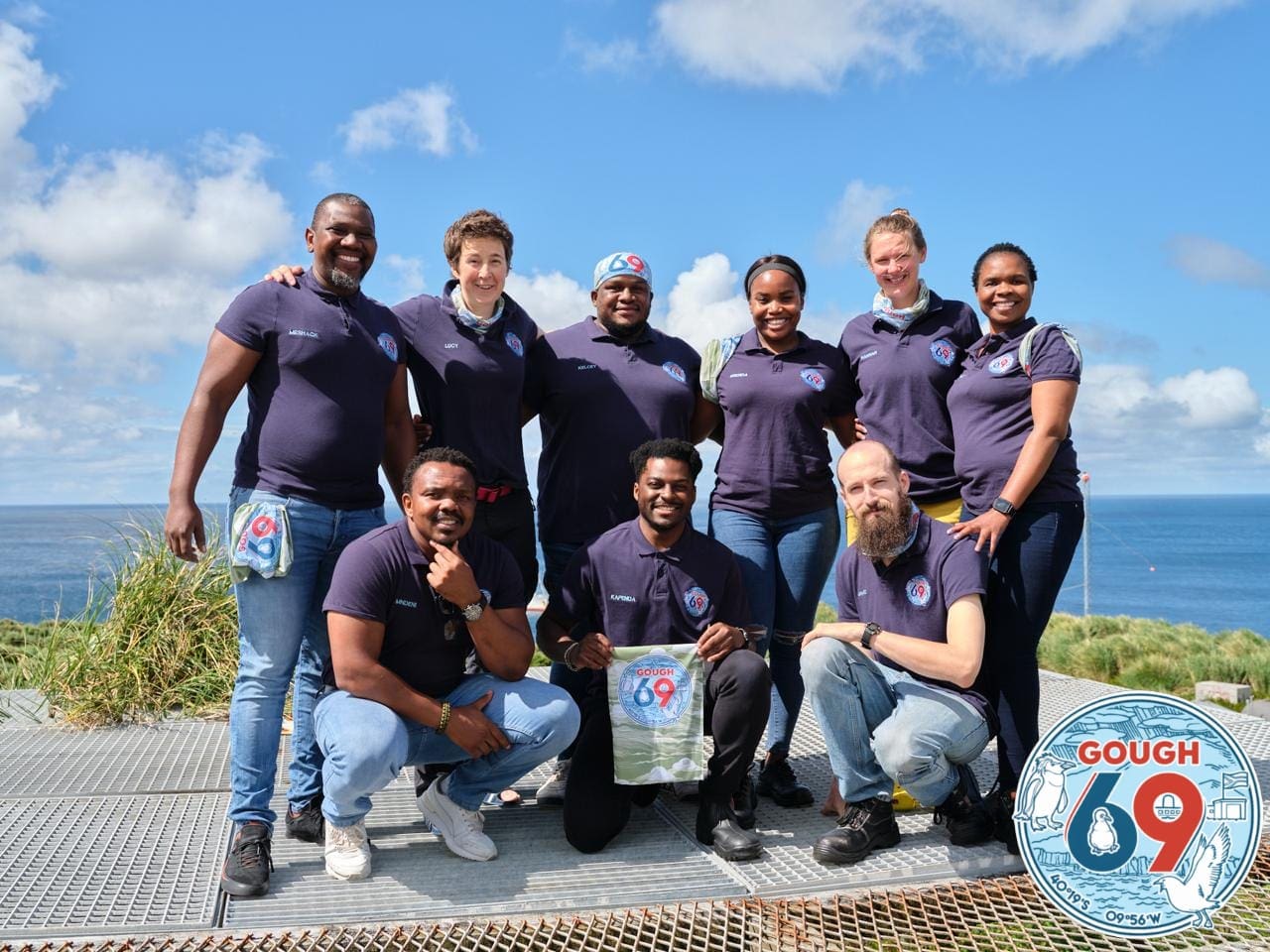 (Back L – R) Meshack Mogorosi – Diesel Mechanic (DFFE) and Team Leader; Lucy Dorman – Field Assistant – Birder (RSPB); Mbulaheni Kelcey Maewashe – Senior Meteorological Technician (SAWS); Fulufhelo Brenda Khobo – Meteorological Technician (SAWS); Hannah Greetham – Field Assistant – Birder (RSPB); Fulufhelo Singo – Electrical Engineer (DFFE)
(Back L – R) Meshack Mogorosi – Diesel Mechanic (DFFE) and Team Leader; Lucy Dorman – Field Assistant – Birder (RSPB); Mbulaheni Kelcey Maewashe – Senior Meteorological Technician (SAWS); Fulufhelo Brenda Khobo – Meteorological Technician (SAWS); Hannah Greetham – Field Assistant – Birder (RSPB); Fulufhelo Singo – Electrical Engineer (DFFE)